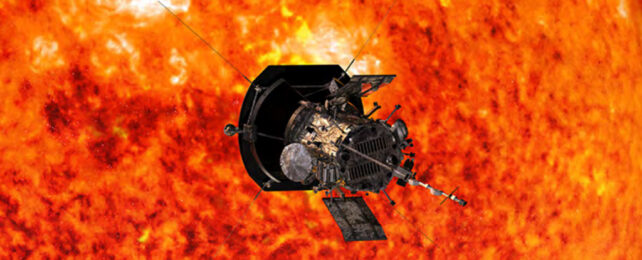NASA's Parker Solar Probe, tasked with taking a close-up look at the Sun's outer corona, has just equalled the record for the fastest-moving human-made object ever.
The previous record holder? The Parker Solar Probe, again.
The probe was recorded traveling at 635,266 kilometers (394,736 miles) per hour on June 29, the second time it's reached that speed since it launched in 2018. We're talking around 500 times faster than the speed of sound here.
It's on course to get even faster too, with a top speed of around 692,000 kph (430,000 mph) expected when it makes its closest approach to the Sun in 2025. That's fast enough to get from Washington, DC to Tokyo in under a minute.
Reaching these incredible speeds is all about timing and momentum. As the Parker Solar Probe loops around the Sun it aligns with the orbit of Venus, using the moving planet's gravity to create a sort of gravity-powered slingshot.
The probe is eventually going to get nice and close to the swirling mass of ultra-hot plasma surrounding the Sun, and take a wealth of different measurements to help improve our scientific understanding of it.
In April 2021, the probe 'touched' our nearest star for the first time, collecting plasma samples and measuring changes in its magnetic field. The spacecraft is putting together a hugely valuable bank of data that we can't hope to collect from here on Earth – and as time-lapse footage released by NASA shows, it's a spectacular fly-by.
Parker has now completed its 20th close approach, coming within 7.26 million kilometers of the layer of ionized gas considered to be the Sun's surface. Eventually, it should get within 6.12 million kilometers.
And of course the probe has to be sturdy enough to withstand not just these incredible speeds, but incredible heat and radiation. The spacecraft's protection includes an 11.4-centimeter (4.5-inch) carbon-composite shield which is capable of withstanding temperatures of nearly 1,371 degrees Celsius (2,500 degrees Fahrenheit).
The title of the fastest human-made object is unlikely to be taken away from the Parker Solar Probe anytime soon, and when the record does eventually fall again, it'll probably be another spacecraft that takes it.
At one stage, the record was believed to be held by a nuclear test borehole cover, which was blasted towards space at an estimated 240,000 kilometers per hour (about 150,000 miles per hour) after the bomb was detonated underground.
The important scientific work of Parker continues, as it continues its record-breaking journey. You can keep up with its progress on NASA's official site.
